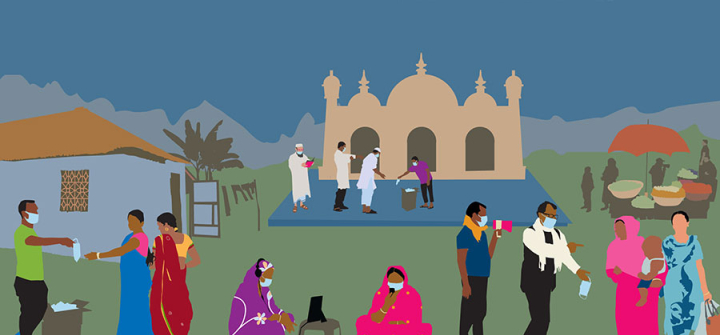Q&A: The Massive Bangladesh Mask Trial, Unmasked
Early in the pandemic, mask skeptics asked for the evidence.
So, a team of Yale and Stanford researchers designed a trial of nearly 350,000 people from 600 rural villages in Bangladesh from November 2020 through April 2021 to answer the question: Do masks protect against COVID-19?
The answer is yes: Masks reduced symptomatic SARS-CoV-2 infections by about 11%, according to evidence from the randomized, controlled trial—“the gold standard for evaluating public health interventions,” says Steve Luby, MD, a Stanford professor of Medicine, in a news release. Results were even more promising for people ages 60+, who were 35% less likely to get sick. And, low-cost promotions nearly tripled mask uptake.
The study, which used a pair-wise randomization to select 300 intervention and 300 comparison villages [which continued mask-wearing as usual], is currently under peer review ahead of publication in Science. The publication, however, allowed the authors to release a preprint draft on September 1, given the trial’s relevance to current policy debates. 2 of the lead authors—Ashley Styczynski, MD, MPH, an infectious disease fellow at Stanford, and Laura Kwong, PhD, a former Stanford postdoctoral scholar who is currently an assistant professor at the University of California-Berkeley—shared some key takeaways with GHN’s Dayna Kerecman Myers.
*******
What factors made Bangladesh an ideal choice?
AS: 2 senior study investigators had longstanding connections with local NGOs, the government, and other research institutions in Bangladesh, so we got their input and support early on. Also, Bangladesh is the seventh most populous country in the world—and first in population density—so we felt the potential impact on transmission was very high, and that Bangladesh would benefit from an effective intervention.
Were the results what you expected?
AS: It might be easy to disregard the findings as not very clinically relevant if you don’t consider some of the external contexts. We only increased mask wearing by 29 percentage points. With higher rates of masking, we may have seen a larger effect. Additionally, case ascertainment was dependent on having COVID-like symptoms, so we may have missed very mild or asymptomatic infections. Additionally, this study unfolded between COVID waves in Bangladesh, when transmission was very low—test positivity was around 2-3%.
How did you measure compliance and social signaling in support of masks?
LK: Masks are really interesting interventions because they’re visible, unlike so many things that we try to get people to do—whether it’s hand washing, or taking medicine—that are harder to build a norm around. The mask itself was a social signal. We also added signs and posters (e.g., for people to hang on their door). Involving religious and political leaders also proved key; mask promotion by imams at Friday prayers proved very important.
For the mask promotions, some people received altruistic messaging (e.g., good parents wear masks to protect their children and the elderly); others got messages with language about self-protection; others got financial incentives. Masks were then color-coded to reveal [to plainclothes volunteers tracking sightings out in communities] which promotion or messages they got.
How could the study sway policy?
LK: The value of surgical masks is a big takeaway. We decided to pass out both cloth and surgical masks in this intervention; we designed the cloth masks used, with a filtration efficiency of ~35-40%—3-4 times higher than typical cloth masks. The more we tried to improve the design of the cloth mask, the closer we got to a surgical mask, so we decided to test surgical masks too. The decision allowed us to include more people in the study, because surgical masks are $0.05 compared to $0.40 for cloth.
Wearing a mask is such a simple thing to do to protect yourself and other people; we can prevent a lot of disease and death that way. And if you’re going to wear a mask, why not wear something that will really protect you? Stronger requirements for high-performance surgical masks and KN95s could help everybody.
Did usage fall off after the masks were no longer provided for free?
LK: During the intervention, when we promoted and distributed free masks, mask-wearing was almost 30 percentage points higher in the intervention group than the comparison group [that continued to wear masks without extra promotion or distribution]. 3 months after we had stopped providing free masks, mask-wearing was still 10 percentage points higher in the intervention group.
Other takeaways for countries (e.g. the US) struggling with mask acceptance?
AS: In the US, we need to do work still on finding messaging that works. The US is obviously not rural Bangladesh, and there are a lot of differences in terms of role models and how society functions; plenty of masking campaigns in the US by celebrities weren’t shown to be very effective.
The study may be even more relevant now because we’re dealing with more transmissible variants than the Alpha variant that was circulating in Bangladesh during the study. With the Delta variant dominant across much of the world, even vaccinated people are able to transmit—making masks and distancing all the more important.
We also estimated that rolling out a scaled-up version, say, countrywide, would be highly cost effective—about $10,000 per life saved. That’s comparable to estimates around the use of bed nets to prevent malaria deaths.
Do you have plans to undertake similar studies elsewhere?
LK: We’re currently working on an urban adaptation of the model in Lahore, Pakistan, led by Maha Rehman and a team from the Lahore University of Management Sciences. The elements are very similar, although this one is just about mask-wearing, not measuring infections.
We’re also thinking about how the Bangladesh findings might inform the promotion of other interventions—including vaccines. Rehman and the Lahore University of Management Sciences team is leading another intervention to distribute highly visible bracelets for COVID vaccines [modeled on prior childhood vaccine interventions] that send the message, “I have a vaccine, I believe in this, I think it’s a good idea.” That’s how we’re trying to boost acceptance—by creating a norm.
This interview has been edited for clarity and length.
Join the 50,000+ subscribers in 170+ countries who rely on Global Health NOW for the latest public health news. Sign up for our free weekday newsletter, and please share the link with friends and colleagues.
Illustration by Gail Welsh, courtesy of Innovations for Poverty Action





